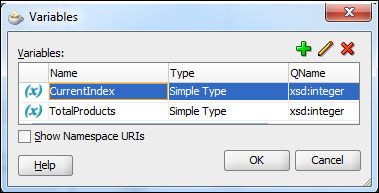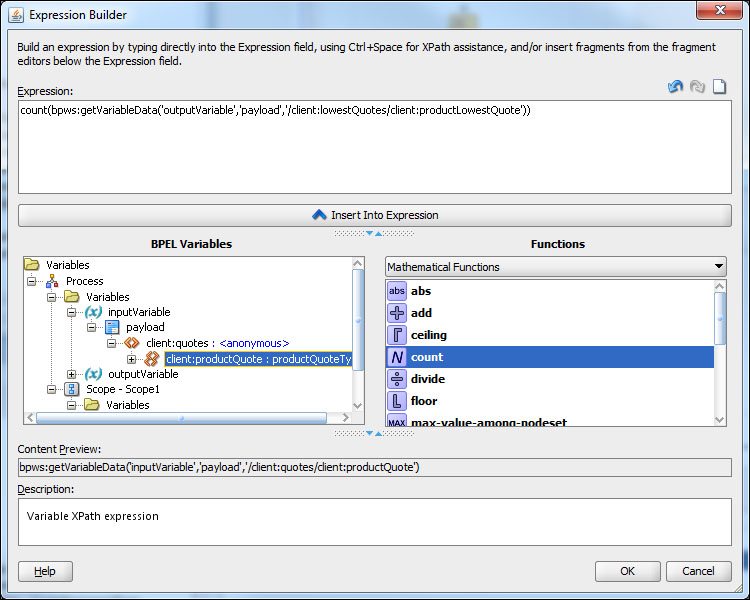Sometimes we need to iterate over array elements in a BPEL process while performing an action such as a BPEL invoke. This requires us to process repeating elements outside of an XSLT transform. In this recipe, we examine how to access repeating elements in an assign statement. We will iterate over the elements in a node-set; elements in the set are indexed starting with one.
We will need a source XML document to iterate over, and a target XML document to update with the results of our iteration.
- Create an index variable to keep track of the current index of the array. The variable should be of the integer type:

- Create a variable to hold the number of items in the array; again this should be of the type integer.
- Use an assign statement to initialize the current index to
0. - Use an assign statement to initialize the number of items to the number of elements to iterate over. The number of elements that need to be iterated over can be calculated by using the XPath
countfunction and passing it to the node-set corresponding to the elements to be iterated over, as shown in the following code:count(bpws:getVariableData('outputVariable', 'payload', '/client:lowestQuotes/client:productLowestQuote'))This can be created by dragging the expression editor onto the number of items variable, and in the Expression Builder by selecting Functions | Mathematical Functions | count and hitting Insert Into Expression. Then, select the elements to be iterated over and insert that XPath into the expression between the parentheses after the count function:

- Create a
whileloop in the BPEL process by dragging the Component Palette | BPEL Constructs | While onto the BPEL process at the location where we want a loop. Open thewhileactivity and use the expression editor to create a suitable loop condition using the loop counter variable and the number of items variable; see the following example:bpws:getVariableData('CurrentIndex') < bpws:getVariableData('TotalProducts') - Before using the current index variable, we need to increment it because XPath node-sets are indexed starting with one.
- When we need to access the current element in the
whileloop, we do it by indexing the repeating element with the current index variable, as shown in the following sample XPath, to select aproductLowestQuoterecord's product name:bpws:getVariableData('outputVariable','payload') /client:productLowestQuote [bpws:getVariableData('CurrentIndex')] /client:productNameNote, that we can use this method to index either a source or a target variable.
When we select an element with an XPath expression, it actually returns a node-set of zero or more elements. If the result returns more than one node (the cardinality of the node-set is greater than one), then we can use the index variable and the while loop to iterate across the elements in the node-set. It is important to remember when selecting from a node-set that the first element in the node-set is indexed by one.
If we need to add elements to a sequence in an assign statement rather than just modify them, we need to use InsertAfter to place an XML Fragment at the correct point in the output document.
The ArrayProcessing project in the code samples has a sample BPEL process called ArrayProcess.bpel demonstrating this.
